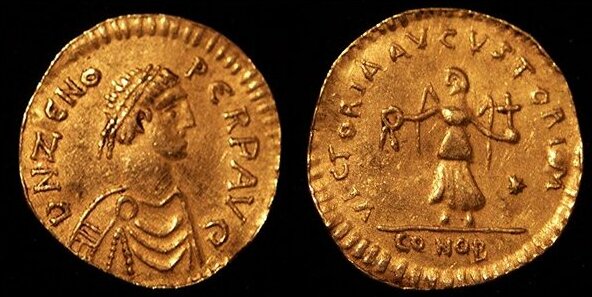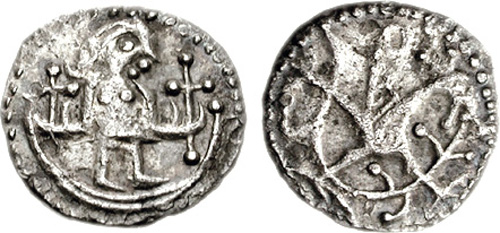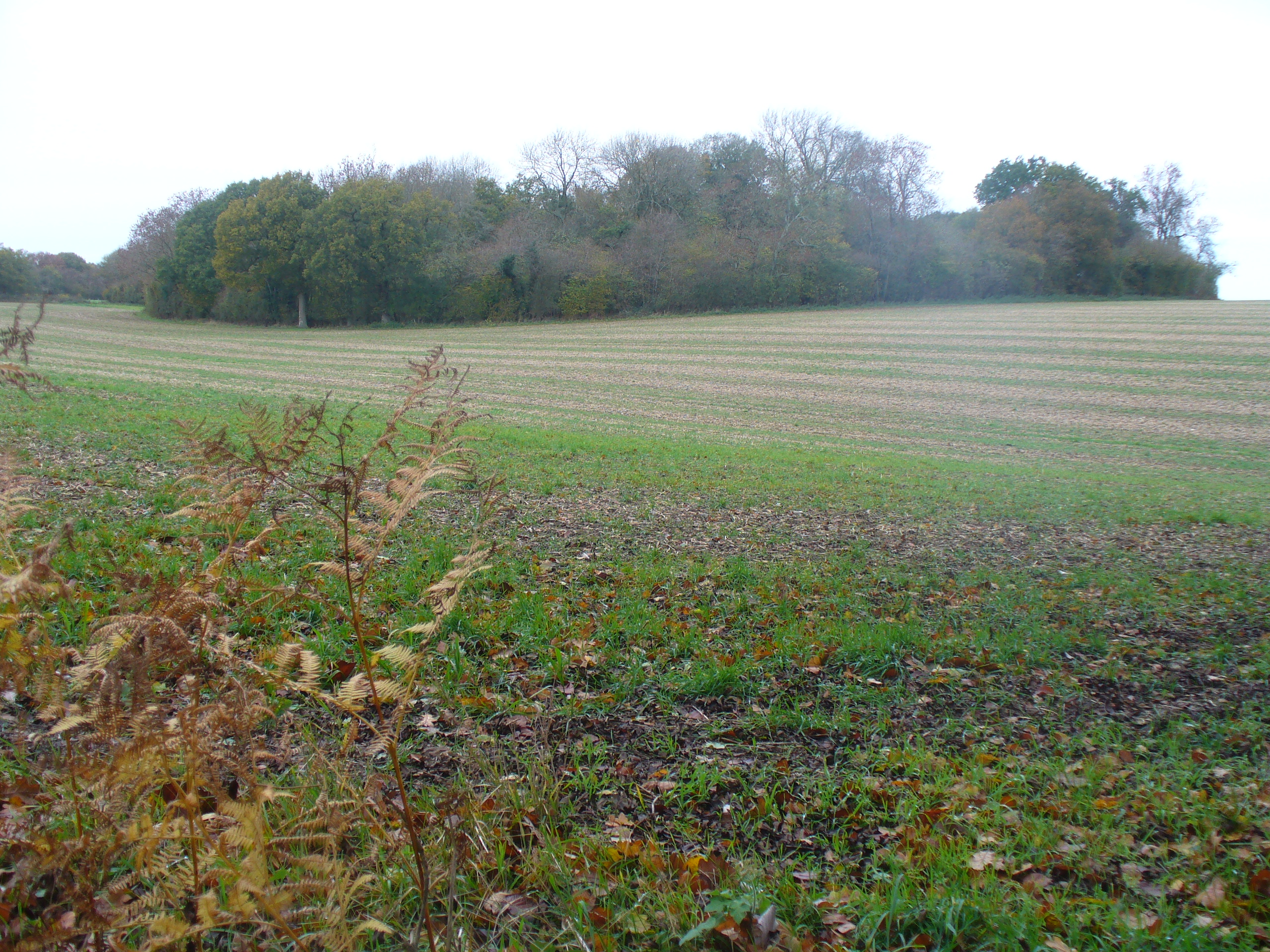|
Thrymsa
The thrymsa () was a gold coin minted in seventh-century Anglo-Saxon England. It originated as a copy of Merovingian tremisses and earlier Roman coins with a high gold content. Continued debasement between the 630s and the 650s reduced the gold content in newly minted coins such that after c. 655 the percentage of gold in a new coin was less than 35%. The thrymsa ceased to be minted after about 675 and was superseded by the silver sceat. History The first thrymsas were minted in England in the 630s. These earliest coins were created at mints in Canterbury, London, and perhaps also Winchester. Charles Arnold-Baker in his ''Companion to British History'' suggests that the impetus for the creation of this coin was increased commerce following the marriage of Æthelberht of Kent and Bertha of Kent, a daughter of the Frankish king Charibert I. Thrymsas originally contained between 40% and 70% gold, but following continued debasement those coins minted after c. 655 contained less tha ... [...More Info...] [...Related Items...] OR: [Wikipedia] [Google] [Baidu] |
Tremissis
The tremissis or tremis (Greek: τριμίσιον, ''trimision'') was a small solid gold coin of Late Antiquity. Its name, meaning "a third of a unit", formed by analogy with semissis (half of a unit), indicated its value relative to the solidus. It was introduced into Roman currency in the 380s by the Emperor Theodosius I and initially weighed 8 siliquae (equivalent to 1.52 grams). Philip Grierson, "Tremissis", in Alexander Kazhdan, ed., ''The Oxford Dictionary of Byzantium'' (Oxford University Press, 1991 nline 2005, vol. 3, p. 2113. Roman tremisses continued to be commonly minted into the reign of Leo III (717–741), but thereafter they were only rarely struck in the east of the empire, probably only for ceremonial uses, until the reign of Basil I (867–886), after which they disappeared. Nevertheless, the coin continued in common use in the Sicilian theme until the fall of Syracuse in 878. The trachy, introduced in the 11th century, was equivalent in value to the old ... [...More Info...] [...Related Items...] OR: [Wikipedia] [Google] [Baidu] |
Sceat
A ( ; ang, sceatt , ) was a small, thick silver coin minted in England, Frisia, and Jutland during the Anglo-Saxon period that normally weighed 0.8–1.3 grams. History Its name derives from Old English ', meaning "wealth", "money", and "coin", which has been applied to these coins since the 17th century based on interpretations of the legal codes of Mercia and of Kent under its king Æthelberht. It is likely, however, that the coins were more often known to contemporaries as " pennies" ( ang, peningas), much like their successor silver coins. They are very diverse, organized into over a hundred numbered types derived from the British Museum Catalogue of the 1890s and by broader alphabetical classifications laid out by British numismatist Stuart Rigold in the 1970s. The huge volume of finds made in the last thirty years using metal detectors has radically altered understanding of this coinage and, while it is now clear that these coins were in everyday use across eastern ... [...More Info...] [...Related Items...] OR: [Wikipedia] [Google] [Baidu] |
Anglo-Saxon Thrymsa 650-675 AD
The Anglo-Saxons were a cultural group who inhabited England in the Early Middle Ages. They traced their origins to settlers who came to Britain from mainland Europe in the 5th century. However, the ethnogenesis of the Anglo-Saxons happened within Britain, and the identity was not merely imported. Anglo-Saxon identity arose from interaction between incoming groups from several Germanic tribes, both amongst themselves, and with indigenous Britons. Many of the natives, over time, adopted Anglo-Saxon culture and language and were assimilated. The Anglo-Saxons established the concept, and the Kingdom, of England, and though the modern English language owes somewhat less than 26% of its words to their language, this includes the vast majority of words used in everyday speech. Historically, the Anglo-Saxon period denotes the period in Britain between about 450 and 1066, after their initial settlement and up until the Norman Conquest. Higham, Nicholas J., and Martin J. Ryan. ... [...More Info...] [...Related Items...] OR: [Wikipedia] [Google] [Baidu] |
Davies
Davies is a patronymic surname of English or Welsh origin. There are two main theories concerning its beginnings, neither of which has been definitively proven. The first theory contends that it may be a corruption of "Dyfed", the name of a medieval Welsh kingdom located in what is now Carmarthenshire; however, the origin of the kingdom's name is itself disputed, with the traditional belief being that it was founded by the powerful Irish ''Déisi'' dynasty in the third century, or otherwise that it derives from the name of the Demetae people. "Dyfed" as a surname and the related first name "Dafydd" appear from the 12th century, with the latter generally translated into English as "David". The second theory states that it may derive directly from the Hebrew name "David", which is also the name of Wales' patron saint. The surname is the joint-second most common in Wales and the eighth most common in England, where a large percentage of people have Welsh ancestry. Retrieved 21 Ja ... [...More Info...] [...Related Items...] OR: [Wikipedia] [Google] [Baidu] |
Crondall
Crondall () is a village and large civil parish in the north east of Hampshire in England, in the Crondall Hundred surveyed in the Domesday Book of 1086. The village is on the gentle slopes of the low western end of the North Downs range, and has the remains of a Roman villa. Despite the English Reformation, Winchester Cathedral (or its Dean and Chapter) held the chief manors representing much of its land from 975 until 1861. A large collection of Anglo-Saxon and Merovingian coins found in the parish has become known as the Crondall Hoard. Toponymy Various earlier spellings have the intuitive, post-Norman spelling of "u" instead of "o" and the village is still pronounced as it has been for centuries by rooted residents or by those who correctly abstract the sound from 'front': in the 10th century 'Crundelas' was recorded; throughout the 14th century it was 'Crundale'. An Old English crundel was a chalk-pit or lime quarry, and the word has survived in the name of Crondall. The r ... [...More Info...] [...Related Items...] OR: [Wikipedia] [Google] [Baidu] |
Dagobert I
Dagobert I ( la, Dagobertus; 605/603 – 19 January 639 AD) was the king of Austrasia (623–634), king of all the Franks (629–634), and king of Neustria and Burgundy (629–639). He has been described as the last king of the Merovingian dynasty to wield any real royal power. Dagobert was the first of the Frankish kings to be buried in the royal tombs at Saint Denis Basilica. Rule in Austrasia Dagobert was the eldest son of Chlothar II and Haldetrude (575–604) and the grandson of Fredegund. Chlothar had reigned alone over all the Franks since 613. In 622, Chlothar made Dagobert king of Austrasia, almost certainly to bind the Austrasian nobility to the ruling Franks. As a child, Dagobert lived under the care of the Carolingian dynasty forebears and Austrasian magnates, Arnulf of Metz and Pepin of Landen. Chlothar attempted to manage the unstable alliances he had with other noble families throughout much of Dagobert's reign. When Chlothar granted Austrasia to Dagobert ... [...More Info...] [...Related Items...] OR: [Wikipedia] [Google] [Baidu] |
Frankish King
The Franks, Germanic-speaking peoples that invaded the Western Roman Empire in the 5th century, were first led by individuals called dukes and reguli. The earliest group of Franks that rose to prominence was the Salian Merovingians, who conquered most of Roman Gaul, as well as the Gaulish territory of the Visigothic Kingdom, in 507 AD. The sons of Clovis I, the first King of the Franks, conquered the Burgundian and the Alamanni Kingdoms. They acquired a province, called Provence, and went on to make the peoples of the Bavarii and Thuringii their clients. The Merovingians were later replaced by the new Carolingian dynasty in the 8th century. By the late 9th century, the Carolingians themselves had been replaced throughout much of their realm by other dynasties. A timeline of Frankish rulers has been difficult to trace since the realm, according to old Germanic practice, was frequently divided among the sons of a leader upon the leader's death. However, territories wer ... [...More Info...] [...Related Items...] OR: [Wikipedia] [Google] [Baidu] |
Coinage In Anglo-Saxon England
Coinage in Anglo-Saxon England refers to the use of coins, either for monetary value or for other purposes, in Anglo-Saxon England. Archaeologists have uncovered large quantities of coins dating to the Anglo-Saxon period, either from hoards or stray finds, making them one of the most plentiful kinds of artefact that survive from this period. Numismatist M.A.S. Blackburn noted that they provide "a valuable source of evidence for economic, administrative and political history." In recent years, the growth of the metal detecting hobby has allowed many more individual coins not in hoards to be discovered, helping to guide current research. History 5th to 7th centuries Early in the 5th century CE, when Britannia, broadly comprising what is now England and Wales, ceased to be a province of the Roman Empire, the production of coinage effectively came to an end and a non-monetary economy developed. During the 5th century, Anglo-Saxon tribal groups from continental Europe migrated to cent ... [...More Info...] [...Related Items...] OR: [Wikipedia] [Google] [Baidu] |
History Of The English Penny (c
The English penny (plural "pence"), originally a coin of pure silver, was introduced by King Offa of Mercia. These coins were similar in size and weight to the continental '' deniers'' of the period and to the Anglo-Saxon sceats which had preceded it. Throughout the period of the Kingdom of England, from its beginnings in the 9th century, the penny was produced in silver. Pennies of the same nominal value, of a pound sterling, were in circulation continuously until the creation of the Kingdom of Great Britain in 1707. Etymology The name "penny" comes from the Old English ''pennige'' (), sharing the same root as the German ''Pfennig''. Its abbreviation d. comes from the Roman ''denarius'' and was used until decimalisation in 1971. Idioms Due to their ubiquity pennies have accumulated a great number of idioms to their name usually recognizing them for their commonality and minuscule value. These might include: *cut (one) off without a penny *mean enough to steal a penny ... [...More Info...] [...Related Items...] OR: [Wikipedia] [Google] [Baidu] |
Anglo-Saxon Runes
Anglo-Saxon runes ( ang, rūna ᚱᚢᚾᚪ) are runes used by the early Anglo-Saxons as an alphabet in their writing system. The characters are known collectively as the futhorc (ᚠᚢᚦᚩᚱᚳ ''fuþorc'') from the Old English sound values of the first six runes. The futhorc was a development from the 24-character Elder Futhark. Since the futhorc runes are thought to have first been used in Frisia before the Anglo-Saxon settlement of Britain, they have also been called Anglo-Frisian runes. They were likely to have been used from the 5th century onward, recording Old English and Old Frisian. They were gradually supplanted in Anglo-Saxon England by the Old English Latin alphabet introduced by Irish missionaries. Futhorc runes were no longer in common use by the eleventh century, but The Byrhtferth's Manuscript (MS Oxford St John's College 17) indicates that fairly accurate understanding of them persisted into at least the twelfth century. History There are competin ... [...More Info...] [...Related Items...] OR: [Wikipedia] [Google] [Baidu] |
Page
Page most commonly refers to: * Page (paper), one side of a leaf of paper, as in a book Page, PAGE, pages, or paging may also refer to: Roles * Page (assistance occupation), a professional occupation * Page (servant), traditionally a young male servant * Page (wedding attendant) People with the name * Page (given name) * Page (surname) Places Australia * Page, Australian Capital Territory, a suburb of Canberra * Division of Page, New South Wales * Pages River, a tributary of the Hunter River catchment in New South Wales, Australia * The Pages, South Australia, two islands and a reef ** The Pages Conservation Park, a protected area in South Australia United States * Page, Arizona, a city * Page, Indiana * Page, Minneapolis, Minnesota, a neighborhood * Page, Nebraska, a village * Page, North Dakota, a city * Page, Oklahoma, an unincorporated community * Page, Virginia * Page, Washington, a ghost town * Page, West Virginia, a census-designated place * Page Airport (dis ... [...More Info...] [...Related Items...] OR: [Wikipedia] [Google] [Baidu] |
Franks
The Franks ( la, Franci or ) were a group of Germanic peoples whose name was first mentioned in 3rd-century Roman sources, and associated with tribes between the Lower Rhine and the Ems River, on the edge of the Roman Empire.H. Schutz: Tools, Weapons and Ornaments: Germanic Material Culture in Pre-Carolingian Central Europe, 400-750. BRILL, 2001, p.42. Later the term was associated with Romanization (cultural), Romanized Germanic dynasties within the collapsing Western Roman Empire, who eventually commanded the whole region between the rivers Loire and Rhine. They imposed power over many other post-Roman kingdoms and Germanic peoples. Beginning with Charlemagne in 800, Frankish rulers were given recognition by the Catholic Church as successors to the old rulers of the Western Roman Empire. Although the Frankish name does not appear until the 3rd century, at least some of the original Frankish tribes had long been known to the Romans under their own names, both as allies providi ... [...More Info...] [...Related Items...] OR: [Wikipedia] [Google] [Baidu] |







